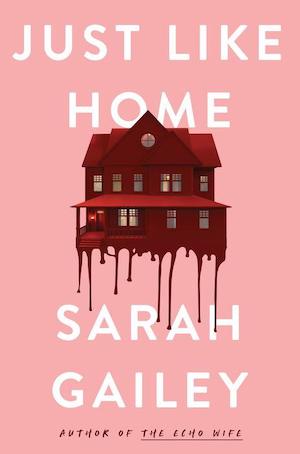After her dying, estranged mother calls Vera Crowder back home, she packs her itinerant life into her car and drives cross-country. Returning to the house her father—an infamous serial killer—built with his own hands, brick by brick, is challenge enough. On arrival, however, she finds a parasitic artist renting space in their backyard shed, aiming to “collaborate” with the house’s psychic residues to craft his installation works. Between her ailing mother’s cruel mood swings, an interloper consuming her childhood memories for inspiration, the legacy of her father’s love alongside his crimes, and the Crowder house itself, Vera’s attempts to settle the estate rapidly devolve. Secrets, lies, and rot: what else lurks beneath those glossy floorboards?
Just Like Home is a vicious and visceral gothic horror story dedicated to “everyone who ever loved a monster.” One of the book’s opening questions is, how does someone wrestle with the knowledge that their beloved father—whose steady love offered protection from an abusive mother—was also a murderous sadist? Nothing gets easier, or gentler, or more pleasant from there as the Crowder narrative unfolds. Their familial psychodrama stitches cruelty, affection, eros, and fear together into a tapestry of betrayal. Vera is a taciturn, withholding protagonist. Returning to the house of her dreams and nightmares pries her open a fraction at a time, and as the novel progresses, the reader begins to understand—hair-raisingly!—that Francis Crowder was far from the only monster of the house
One of the first things a keen-eyed reader will notice about Just Like Home is its distinctive homage to Shirley Jackson’s famous novel, The Haunting of Hill House. On the level of genre and the level of prose, Gailey’s novel draws from both Jackson and the broader tropes of the gothic. We’ve got a cold, imperious mother figure whose jealousy of her daughter holds incestuous undertones; histories of violence preserved under plexiglass for audiences like the artist-medium Duvall to consume; secrets and lies buried within a house that seems to breathe on its own. A fairly literal “return of the repressed” forms the gruesome, central theme of the book!
But Gailey has also borrowed luxuriously from other genres—such as true crime, serial killer fiction, and thrillers. The current popularity of true crime casts a particular pall over the text. For example, after evicting her seventeen year old daughter, Daphne Crowder spent the intervening years selling tours and artists’ residencies for the house her husband committed his torture-murders in. The comingling of gothic, shadowy secrets with true crime’s halogen-light glare creates a disorienting effect on the reader. We think we know everything, that it’s already been sold to us, but… we really, really haven’t heard the whole story.
Buy the Book


Just Like Home
Major spoilers follow.
The novel plays with this tension by shifting between the current timeline of Vera’s return home, written in the past tense, and recollections from her childhood, written in the present tense with eerie foreshadowing future tense scattered throughout. Dread builds across these flashbacks as the reader begins to suspect—and then has confirmed—young Vera’s burgeoning involvement with her dad’s serial murders. First she watches through a peephole in her bedroom floor… and then she gets the courage to act on her own. I’d take the terror of ‘letting a leg slip off the bed to get grabbed by a ghost’ over the terror of the folie à deux driving thirteen year old Vera to mutilate her childhood best friend in the basement any day.
Furthermore, the novel’s exploration of being a child in an abusive household adds a depth of realist horror: punishments for failing to predict a mother’s fits of rage, the ways adults withhold vital information then blame children for their errors in judgement, emotional cruelty and physical neglect plus social isolation. And adult Vera’s return home to clear out the possessions of her dying mother while the woman is still alive to watch—the same mother who finally admits to loathing her and being jealous of how much attention Francis always paid to her—now, that’s truly nightmarish.
But lest we forget, the novel’s true center is its spooky house—the house, as the reader is constantly reminded, that Francis built “with his two strong hands” to be perfect for his family. Gothics require eerie houses with buried secrets, and Gailey echoes The Haunting of Hill House by asking the question: what if the house itself was a living character, one who might be malevolent? Just Like Home‘s opening line, “The Crowder House clung to the soil the way damp air clings to hot skin,” presages all the nastiness to come: uncomfortable, erotic, and ever-so-faintly rotten. The house serves as metaphor, location, history, womb, and genre reference all at the same time.
Near the middle of the novel, Gailey writes,
[Vera] exhaled and the Crowder House sucked up the air that left her. She took her shoes off and the warmth of her feet went into the cold floorboards. She brushed her teeth and when she spat into the sink, whatever had been in her mouth coated the insides of the drain like plaque lining an artery. The skin that fell from her body and the hair that dropped from her scalp drifted into corners and under furniture, a soft lining for every gap and every edge in the house.
On second reading, I was even more struck by the work this paragraph does. As we discover near the end, the house itself—embodied as a gruesome, fleshly thing—has adored Vera and tried to protect her for her entire life. For example, it tried to muffle the sounds of fights between her parents… so she wouldn’t know her mother was the one pushing Francis toward his escalated murder schedule on purpose. (Big yikes!) The ghost is the house is the ghost; the house is a creature enfolding Vera in its love as it consumes her remains. The house has even gone so far as to wear the corpse of Daphne to offer some maternal closure and to beg Vera for rescue from Duvall, the destructive artist-in-residence.
The artist whomst the house and Vera do, in fact, end up murdering together.
All of that, by the way, is as awful and tender as it sounds. Honestly, I don’t think I’ve ever read a haunted house story that ends with the protagonist and her monster forming a sensual attachment before? What an evocative, disturbing communion Gailey has crafted here. The house-creature is “the color of a struggling nightcrawler […] a hot, visceral pink, marbled with dark veins, aggressively flesh,” possessing no hands but long many-jointed fingers instead, with an elongated grease-oozing body. And “all of it, every angle and color and shadow, made Vera ache with want.” Whatever sex and desire are in this novel—and boy, could that be the topic of an entire secondary essay—the intimacies shared by Vera and the house come closest to something pleasurable and consensual.
Admittedly, one of those intimacies is the stripping, the shredding, of her mother’s rotting corpse off from its body. Another is Vera’s comfort in the knowledge that she and the house were created for one another by Daphne and Francis. Like I said, it’s a gothic novel in truest form—especially regarding the grim, vaguely incestuous libidinal energies throughout. Both Just Like Home and Gailey’s prior novel, The Echo Wife, wrestle complexly with abuse, trauma, and violence through the experiences of troubled (and troubling) protagonists. But where The Echo Wife was a fairly cerebral sf thriller, this book focuses largely on feelings: those nasty, intense, bodily, aggressive feelings commonly associated with monstrousness.
Vibes-based emotional extremity, however, doesn’t always lend itself to measured pacing or plot—and Just Like Home does struggle in the final third to balance its narratives. The artist Duvall’s deeply gendered threats and aggression against Vera and the house, the ugly truths behind the Francis/Daphne/Vera psychosexual dramas from her teenage years, and the escalating haunting plus the house-creature’s revelation: it’s a lot to wrangle! While Gailey does bind them together, the stitching strains a little against the weight. With a novel this ambitious and deranged, though, perhaps the gut-churning sprint of gore, desire, and rebirth Gailey provides is the only proper way to finish—as opposed to a smoother, neater descent.
As Vera says in the final paragraphs, she’s neither good nor bad, clean nor foul. What she is, is “hungry.”
Just Like Home is available from Tor Books.
Lee Mandelo (he/they) is a writer, critic, and occasional editor whose fields of interest include speculative and queer fiction–especially where the two coincide. Summer Sons, their spooky gay debut novel, was recently published by Tordotcom, with other stories featuring in magazines like Uncanny and Nightmare. Aside from a brief stint overseas, Lee has spent their life ranging across Kentucky, currently living in Lexington and pursuing a PhD in Gender Studies at the University of Kentucky.










